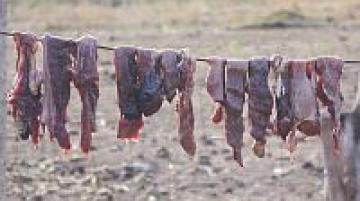362 cattle found dead

MBABANE - A total of 362 cattle have been killed in the Manzini region in just one week.
The cause of death has been identified as hypothermia that came about as a result of the incessant rainfall and subsequent low temperatures experienced from last Tuesday.
Director of Veterinary and Livestock Services Dr Xolani Dlamini, said the toll rose to 362 yesterday.
This figure only reflects cattle reported to have died by 5pm yesterday.
Dlamini said following autopsies conducted on the dead cattle, it was discovered that the main cause of death was cold temperatures.
Most cattle that died were calves and cows which were not well fed, kept in kraals with mud and lacked sufficient fat in their bodies to withstand the harsh temperatures.
"The number of cattle that died as a result of hypothermia, which is a natural disaster that will show Swazi farmers the importance of keeping livestock in good health.
"I am saying this because, had the cattle been well fed and stayed in kraals with less mud, the number of dead cattle would not have escalated to over a hundred.
"What exacerbated the situation is that during winter there are less salts in grass, a factor which made the cattle unable to withstand extremely cold temperatures," said Dlamini.
More deaths are anticipated with numbers likely to escalate to 1 000 countrywide by Friday.
The Ministry of Agriculture said final statistics would be released on Friday afternoon.
"We are still in the process of collating information from all dip tanks countrywide but the numbers are likely to increase because the cold temperatures still persist," noted Dlamini.
‘Don’t consume meat from the dead cattle’
MBABANE - Consuming meat from the 362 dead cattle has been discouraged.
Though the meat may not be classified as poisonous per se, the public has been warned not to consume it.
The Director of Veterinary and Livestock Services, Dr Xolani Dlamini advised members of the public to dispose of the meat.
"It is not safe to eat the remains of the dead cattle because the reasons why they could not sustain cold temperatures differ. Some were not well fed and lacked sufficient fat, yet others might have had diseases that made them unable to withstand the low temperatures.
"Therefore, for safety purposes, it is advisable that members of the public do not consume the meat. After all, meat from some of the dead cattle would not have been allowed in our abattoirs, so why would the public want to consume meat from unhealthy cattle," wondered Dlamini.
The Minister of Agriculture, Clement Dlamini, also shared the same sentiments on Monday.
"We have received reports that some people are already selling the cattle to butchery owners. Therefore, we would like to warn butchery owners to be on the lookout for such culprits," said Dlamini.
Manzini dip tank stats:
Ntabamhloshana - 50 (cattle)
Bantwanyana - 14
Thulwane - 40
Nkulujana - 23
Mkhumbane - 46
Lugulu - 45
Mhlamanti - 23
Sncuduma - 75
Mahlangatsha - 46
... meat exports will not be affected
MBABANE - Meat exports will not be affected by the death of about 362 cattle, as a result of hypothermia.
Director of Veterinary and Livestock Services, Dr Xolani Dlamini, assured yesterday.
"There will be no negative impact on meat exports since none of the cattle at feedlots were reported dead.
"Further, the cattle whose meat we export as a country, are well fed and kept in good condition," noted Dlamini.
Most of the cattle reported dead were not in a good health condition and lacked sufficient fat to shield them from the cold temperatures.
In 2011, Swaziland exported 460 tonnes of beef to Norway.
Other countries where the country exports large quantities of meat to include: Mozambique, European Union states, and South Africa among others.




 del.icio.us
del.icio.us Digg
Digg